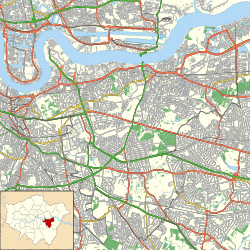Deptford pumping station
Deptford Pumping Station is a sewage pumping station built in 1865 to the east of Deptford. It is part of the London sewerage system devised by Sir Joseph Bazalgette in the mid 19th century. Today operated by Thames Water, it is located on the western side of Norman Road, approximately 0.5 km (0.31 mi) south west of Greenwich town centre, on the eastern bank of Deptford Creek, around 0.5 km (0.31 mi) south of its confluence with the River Thames.
| Deptford pumping station | |
|---|---|
 Location in London Borough of Greenwich | |
| General information | |
| Status | in use |
| Type | Pumping station |
| Architectural style | Italianate |
| Address | 101 Greenwich High Road |
| Town or city | London |
| Country | England |
| Coordinates | 51°28′38″N 0°01′06″W |
| Construction started | 1865 |
| Design and construction | |
| Engineer | Joseph Bazalgette |
Listed Building – Grade II | |
| Designated | 16 December 1988 |
| Reference no. | 1213334 |
History
After an outbreak of cholera in 1853 and "The Big Stink" of 1858, central London's sewerage system was designed by Bazalgette to intercept sewage flows and prevent them flowing into the Thames. A Northern Outfall Sewer intercepted flows north of the river, while the Southern Outfall Sewer took flows south of the Thames. The pumping station at Deptford was the meeting point of three interceptor sewers in the latter system:
- The high-level sewer starts at Herne Hill, and heads eastward under Peckham and New Cross to Deptford.
- The middle-level sewer starts on Balham Hill and runs under Clapham High Street, under Stockwell and Brixton, through Camberwell to Deptford.
- The low-level sewer begins in Putney and runs through Battersea, Vauxhall, and under the Old Kent Road and Bermondsey to Deptford.[1][2]
The pumping station raised sewage flows 18 ft (5.5 m) so that it could then flow under Greenwich, Woolwich, Plumstead and across Erith marshes to a treatment plant at Crossness. In the year 1919/20 the Deptford pumps handled 21,890.1 million gallons (99.514 million cubic metres) and the running costs were £28,818.[3] Deptford was the south London equivalent of Abbey Mills pumping station in West Ham, which performed a similar function on the Northern Outfall Sewer.
The original Deptford pumping station building (now a Grade II listed building) was built in London stock brick in an Italianate style,[4][5] and comprised two engine houses with a linking boiler house.[6] It initially housed four steam-powered beam engines (later replaced by diesel and electric pumps).[7] When installed, the engines at Deptford were the largest ever built.[8][9]
Over 150 years later, the pumping station site will be the location of Greenwich pumping station, part of the Thames Tideway Scheme, currently under construction,[10] and intended to partly supersede Bazalgette's system.
References
- Trench, R. and Hillman, E. (1984) London under London: A Subterranean Guide (London: John Murray), pp.75–76.
- http://www.crossness.org.uk/history/londons-sanitation/how-the-system-worked.html
- London County Council (1922). London Statistics 1920-21 vol. XXVII. London: London County Council. p. 99.
- "Greenwich Pumping Station". London Open House. Retrieved 10 January 2020.
- "Deptford Pumping Station". PortCities. Retrieved 10 January 2020.
- Historic England. "Pair of Beam Engine Houses with Linking Boiler House at Deptford Sewage Pumping Station (1213334)". National Heritage List for England. Retrieved 28 May 2020.
- Phillips, Anthony (2 April 2019). "The man who built London's sewers". Weekender. Retrieved 10 January 2020.
- "How London got its Victorian sewers". Open Learn. Retrieved 10 January 2020.
- Collinson, Alwyn. "How Bazalgette built London's first super-sewer". Museum of London. Retrieved 10 January 2020.
- "Greenwich pumping station". Tideway. Retrieved 10 January 2020.